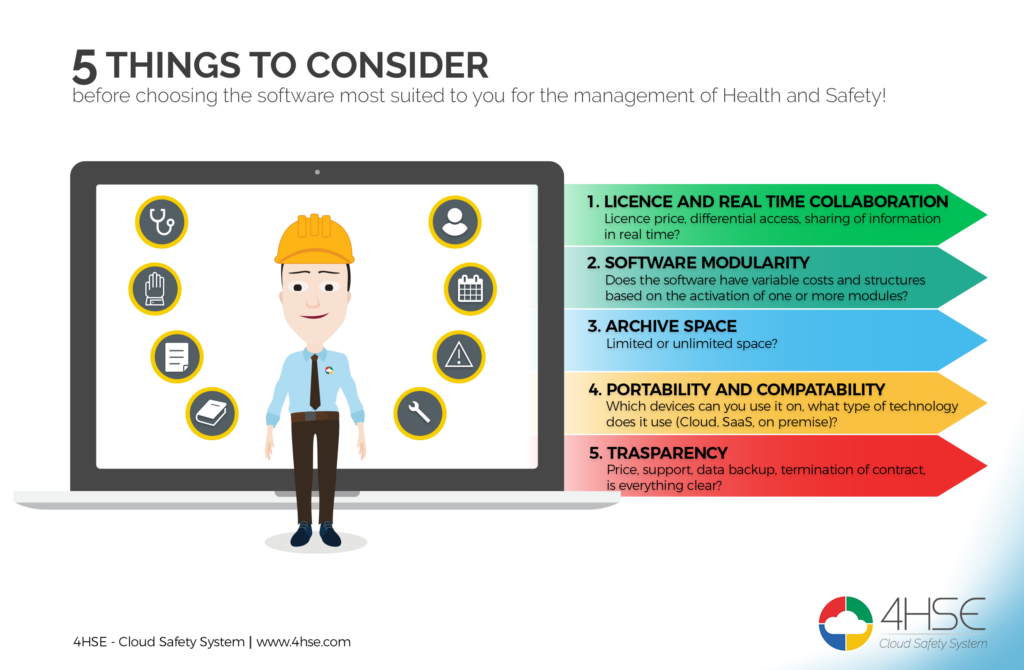Safety in the workplace management: 5 things to know before choosing the software most suited to you

Which is the best software?
The eternal question to which the wrong answer is often given.
During the process of choosing a software for managing safety in the workplace multiple subjective factors come into play that depend on the individual case and the desired features, such as the working method and the budget available. It is precisely because of this subjectivity issue that it is not correct to speak of the “best software” but the “software most suited to your needs”.
In this article we wanted to go beyond the classic cost-functionality relationship and take into consideration other factors, some of which are much more important than just the price tag.

Licence and real time collaboration
When considering licences, the first thing to ask is:
Does the price vary according to the number of users which use the platform?
The question relates to a simple requirement: to understand if the software is priced according to the number of people actively using the software or on the quantity of data handled.
In other words I need to know if I need to buy a licence for each person who contributes to the project (limited users) or whether it is an unlimited users service.
Once this has been determined, it is necessary to ask whether the collaboration with colleagues and/or clients is in real time; therefore if it is possible to work with multiple people contemporarily on the same project.
Can I create differential accesses for each user?
Being able to establish what each user can do or see, is a basic function for certain software but is not obvious in the current market of programmes for managing Health and Safety in the workplace.
Modularity of the software
Is the software structured in modules?
If the answer is yes, find out which modules (functions) are included in the “basic version” and which ones you have to buy separately. Often a solution which may seem to have an economic advantage in reality does not, because not all the tools necessary for reaching your goals are included. Therefore carry out an accurate comparison of the real convenience between a module software and a non-module software, because often the second reveals itself to be much cheaper.
Archive space
Limited or unlimited archive space?
Considering the enormous quantity of documents a Health and Safety manager or consultant has to manage, this question is very important. It is not necessary to underline the importance of asking how many and what type of documents can be archived directly on the platform (and if there are any restrictions to be able to access them like how and what).
Portability and compatibility
Which devices can I use the software on?
A management system for health and safety, which is only available on a computer desktop, may not be sufficient. If you are frequently out of the office for work purposes or if you have to visit building site locations the possibility to access the management system via tablet or smartphone and contemporarily with other colleagues, is not a detail to be underestimated.
Which technology does the software use?
To simplify as much as possible, the types identified are 3:
- On premise: the program is installed directly onto the machine (computer) and managed via a local server. Usually a licence is required for every installation/position.
- Cloud based software: Does not require an installation on your computer and it is managed via remote servers.
- SaaS (Software as a Service): Or Web based software. Its function is based on a cloud and therefore it is not necessary to download or install files. The difference between this and a simple cloud system is that the software is intended as a service supplied to the user: the annual or monthly subscription fee which the user pays includes all automatic updates to the platform and other services.
Once you have established the technology the platform uses, it is necessary to check the compatibility with your operating system and browser.
Transparency
Is everything clear from the start?
Firstly, check the data back-up methods; whether they are automatic or whether it has to be done manually and above all whether the user has the possibility to carry out a back-up themselves. Following this, ensure what will happen to your projects if the relationship that binds you with the supplier terminates.
For the archive space and for the acquisition of accessory modules and services such as printing of documents and certificates, assistance or training, it is always better to accurately check and anticipate all costs which could occur, as well as evaluating any changes in requirements.
Finally, find out the type and method of support which the supplier guarantees; if it is included in the package or if it has to be bought separately.
